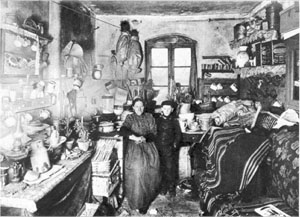Working Assignment
1. Write a letter to the editor of a newspaper in which you portray your poor work and living conditions as a simple factory worker in the year 1900. Refer to the situation of your wife and children, too.
2. Compare the situation of a twelve-year-old child from your school today with the life of a worker’s child of the same age at the end of the 19th century.
What has changed? Are there, maybe, similarities, too?
3. Try to form a critical decision about the validity of picture documents such as this.
Which information appears to be reliable to you, what remains uncertain?
 Click image to enlarge
Click image to enlarge
Source: Picture of a worker’s flat in the 19th century. From Asmus, Gesine (Hrsg.): Hinterhof, Keller und Mansarde-Einblicke in Berliner Wohnungselend 1901-1920, Reinbek 1982, S. 111.
Questionnaire
Questions of synthesis
The work assignments for the students should make them aware how living and housing conditions as well as everyday life of families have changed over the course of centuries.
- The work assignments for the students should make them aware how living and housing conditions as well as everyday life of families have changed over the course of centuries.
- The “typical” course of a working day is to be additionally described and discussed on the basis of the following central questions: When does a working day begin? How does a worker get to his place of work? Is he provided with work clothing? Does he have regulated breaks? What awaits him when he is back home? How is his family? What do his wife and his children do while he works the whole day? When does he get retired? Which benefits does he get/not get in case of absence due to illness?
- By means of comparing a biography of a twelve-year-old child of today and the one of a worker’s child of the same age at the end of the 19th century, the students’ awareness of the specific changes that have taken place should be raised. As a consequence of the establishment of compulsory government-funded education, a child has the right to education today.
- Here, it should be discussed if education is compulsory in every European country and in which countries child labour exists even today. What consequences does this have for the life of children? Where is child labour still practised? The students should find out which course their own life would take if they did not have any right to education and had to work in a factory.



